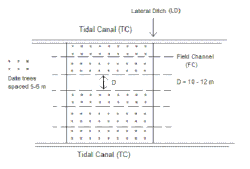Irrigation in Iran: Difference between revisions
+new $1.5 billion project |
Curb Chain (talk | contribs) →References: removed break |
||
| Line 50: | Line 50: | ||
==References== |
==References== |
||
{{Reflist|2}} |
{{Reflist|2}} |
||
{{Irrigation by country}} |
{{Irrigation by country}} |
||
Revision as of 01:00, 24 November 2012
Irrigation in Iran covers 89,930 km2 making it the fifth ranked country in terms of irrigated area.[1]
Tidal irrigation at Abadan island, Iran

The Abadan Island (Fig. 1) in Khūzestān Province is situated between the Arvand and Bahmanshir rivers. The Arvand river (in Arabic: Shatt al-Arab) forms the boundary between Iran and Iraq and collects the waters from the Euphrates and Tigris rivers.
On the island extensive orchards of date palm are found thriving on tidal irrigation in the desert climate, although many date palms were destroyed during the Iraq-Iran war.
Palm tree belt
The palm tree belt stretches along the Arvand River from Abadan south-east over a distance of about 40 km and is bounded in the interior by a road.
The width of the belt varies from 2 to 6 km, and on average it is 4 km. The width is greater in the concave parts of the river bends and smaller in the convex parts. The convex parts have higher river levees and topography.
The total area of the belt is about 16000 ha. The tree spacing is around 6x6 m. There are roughly 300 trees per ha. The maximum yield is about 200 kg/tree and 60 t/ha.
Tidal canals
A sketch of the system of tidal canals [2] is shown in figure 2. They are 2 to 6 km long depending on the topography and spaced at 50 to 60 m.
The tidal canals cut through and serve the levee soils along the river (Fig. 3) and they stop where the basin soils of the backswamps begin.
Between the tidal canals additional lateral ditches have been dug perpendicularly at a spacing of 50 to 60 m to further promote the distribution of the irrigation water.
Field channels originate from the lateral ditches at a spacing of 10 to 12 m and the date palms are planted along these (Fig. 4).
Soil properties
The typical properties of the levee soils are shown in figure 5. There is a well-developed topsoil with a thickness of more than 1 m through which the subsurface irrigation water can move in and out with relative ease.
Simulation tidal propagation
The tidal movements are 2 m on average. A simulation of tidal fluctuations in the ditches is shown in figure 6 for an average and a high river discharge at various distances from the sea. The simulations were made with the Duflow [3] model.
Gallery
- Gallery of figures referred to in the text
-
Fig. 2. A tidal canal stretches from the river inland and distributes the water over the lateral ditches
-
Fig. 3. Longitudinal section of a tidal canal and cross-section through the river levee
-
Fig. 4. The field channels run between the lateral ditches
-
Fig. 5. An impression of soil properties
-
Fig. 6. Simulated tidal movements in canals at different river discharges and at various distances from the sea, assuming a normal tidal range
Project to transfer Caspian Sea water to central regions
According to the plan, water will be transferred from Sari to the city of Semnan within 24 months (starting April 2012). The plan aims to provide central provinces with water for industrial and agricultural purposes at a cost of $1.5 billion. Once the plan comes on stream, some 500 million cubic meters of water will be transferred per annum.[4] After desalination at the point of origin in the Caspian sea, it will be transported through a 500 kilometer (300 mile) -long pipeline to the central Kavir desert, bringing about 200 million cubic meters (7,062 cubic feet) of water per year.[5]
Nearly 14 percent Iran's territory is desert and suffers from prolonged droughts.[6]
The Caspian Sea is shared by Iran, Russia, Kazakhstan, Azerbaijan and Turkmenistan. Its salinity is about a third of that of sea water.[7]
See also
- Water supply and sanitation in Iran
- Garmsar
- Agriculture in Iran
- List of reservoirs and dams in Iran
- List of countries by irrigated land area
References
- ^ CIA World Fact Book
- ^ Consultancy report on the Abadan project. Abvarzan Co., Tehran, Iran, 12 September 2004. Download from web page : [1] , under nr. 1, or directly as PDF : [2]
- ^ Duflow model http://www.mx-groep.nl/duflow/model
- ^ http://www.tehrantimes.com/economy-and-business/96929-iran-to-launch-project-to-transfer-caspian-sea-water-to-central-regions-
- ^ http://news.yahoo.com/iran-launches-1-5b-water-project-caspian-sea-104539767.html
- ^ http://news.yahoo.com/iran-launches-1-5b-water-project-caspian-sea-104539767.html
- ^ http://news.yahoo.com/iran-launches-1-5b-water-project-caspian-sea-104539767.html





